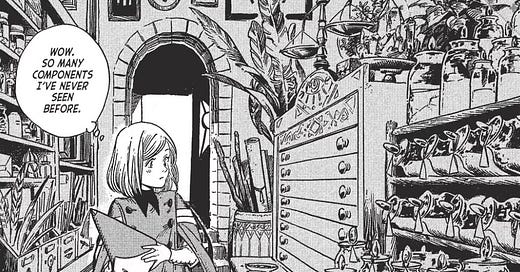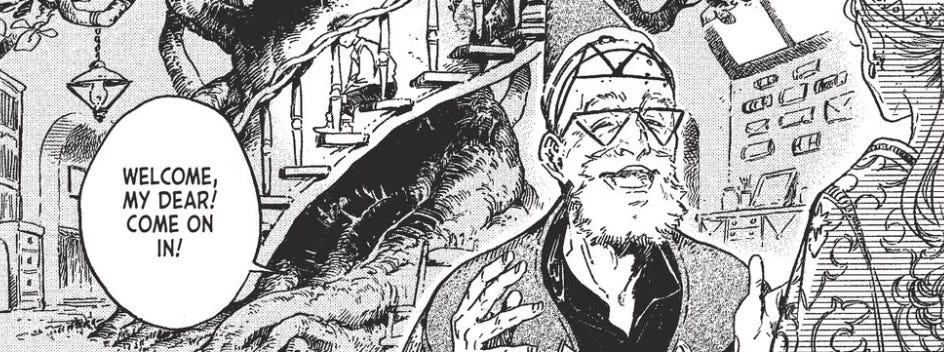Preface!
The longer I go without reading more Witch Hat Atelier, the more in awe I am when I return to it. The art is just… unmatched. It’s the best in the business. I was just saying the other day that I judge the artistic merits of a series by how often I stop to just admire various artistic elements. Layouts, design, whatever it may be.
Witch Hat Atelier stops me frequently. I just want to take in every little detail, from the landscapes to the way panels play with each other, to the vibrant way magic is depicted.
So I guess, as far as the insufferable ask of world building goes (insufferable to me, that is), Witch Hat Atelier has a leg up solely in that it is already so fun to be apart of.
Preface over.
I’ve said this before—as recently as the preface—but I find world building to be… insufferable. Mostly because I’ve seen it done wrong so much that I just inherently assume I’m doing it wrong. It’s that writerly self-doubt in me.
When I write scenes, I just skip the setting until it can’t be skipped anymore. I just can’t not feel clunky as I describe a classroom. I mean… it’s not fun. Even when I try to make it fun.
Granted, in visual storytelling, it’s obviously quite a bit different, and that’s part of the reason I fell in love with writing in this medium. I don’t have to write sentences of setting, I can just tell the artist what to put where. Like a life hack.
But sometimes even that isn’t enough. Sometimes the world can only really come to life when it’s both right there in front of us on the page, and when characters are seamlessly interacting with it.
And that’s where we find Witch Hat Atelier.
Before we get into Witch Hat Atelier, here’s what you need to know.
Coco, a young and impressionable girl with an awe for magic she thinks she could never partake in, accidentally casts a spell that turns her mother to stone. The secrets of magic are unveiled, she becomes a witch and is swept away in this whimsical world alongside fellow magical apprentices and her teacher, Qifrey. While her primary quest is to turn her mother back to normal, she begins to take on more aspirations and responsibilities in this magical world.
And that’s all you need to know.
There’s an inherent benefit to having a well-built world. A world that has all the details to feel as authentic as the world around us. And that inherent benefit is the trust you’re building with your reader. The sooner you can get their mind to set aside the natural boundaries of knowing that the world in this book isn’t real, the sooner they get lost in your work.
But it’s not always that easy. Start dedicating chapters to the etymology of plants and you’re bound to lose a few. Sorry JRR Tolkien… it’s true.
Witch Hat Atelier lives in the sweet spot of world-building. The way that characters interact with the world to organically bring to light the mechanisms of magic, the uses of plants, the conditions that affect people and so much more. With seemingly no effort at all, we, the reader, learn so much about this magical realm without any need for exposition.
As soon as we touch the ground in Witch Hat Atelier, we see the way the world interacts with magic, the reverence “non magical” people have for it, as well as the way it appears—flying carriages and whatnot. But within chapters, Coco is into the world of magic and the curtain is pulled back. Through scenes of organic tutelage, we learn that magic is accessible to all—it’s just drawing.
But tutelage sounds… boring, yeah? To reveal world-building in a classroom setting isn’t exactly a remarkably feat of originality. Witch Hat Atelier sidesteps this with Coco’s organic awe of magic. Since she is fascinated by everything, the small details, like how to draw the proper sigil, can be explained at length in an organic way—Coco is just obsessing over these details. It’s character building opening the door for world building to slip into.
Similarly, in a scene where Qifrey and Coco interact with Tartah, a young shopkeeper who works with plants and herbs, we see a similar effect. Tartah is tasked with using his herbs to help Coco, but there’s a problem—Tartah has silverwash, a condition in the world of Witch Hat Atelier not unlike color-blindness. Everything appears silver.
So now we have a grasp of a particular condition unique to this world, but it is also used as a vessel for Tartah to organically explore his plants and herbs and explain them to Coco, since he can’t tell them apart. It gives him a window of opportunity to solve a problem with magic in a natural manner and along the way, we learn a lot about the various plants he’s dealing with.
You may be saying, “eh, small details, who cares about plant names” and you’re not wrong. But as I mentioned, the more organic details a story has, the more authentic it becomes. The more real. So now we have a world with specific plants, conditions, and magical rules, and none of it comes about through exposition. It all comes about through character. Through Coco’s obsessions. Through Tartah’s ingenuity. Through Qifrey’s moral conundrums. Through Olruggio’s ambition ceiling. The list goes on. The more unique aspects of this world are unveiled, the more tangible the world becomes.
It feels like every post I gush about how character drives everything, and in this case, it’s not unlike the piece I wrote about Gachiakuta using character to reflect setting. The characters in Gachiakuta are the way they are, they act the way they act, because of the world they’re in. Another example of effortless world-building.
Witch Hat Atelier is similar, but different. It’s not just the way the characters are and how they act, but the way they see the world. I can’t stress enough how useful of a tool Coco’s obsession is. Since she’s so new to magic, all of it fascinates her, which gives her all the more reason to tell the reader about the ins and outs of magic. But in the process of doing so, she keeps it fun and lively with her boundless enthusiasm. Again, character opening the door for world-building.
And to bring this all back to the inciting incident—Coco accidentally turns her mom to stone. Okay, that’s a textbook inciting incident. It forces Coco into the magical realm, it gives her a clear cut from her normal life. But it also provides the perfect backdrop for detailed explorations of the various forbidden magic of this world. Delivered organically, of course, given the context of why Coco can’t just use forbidden magic to turn her mom back.
It’s like every little piece of Witch Hat Atelier serves more than one purpose, and one of the purposes is almost always expanding the reader’s understanding of this world.







